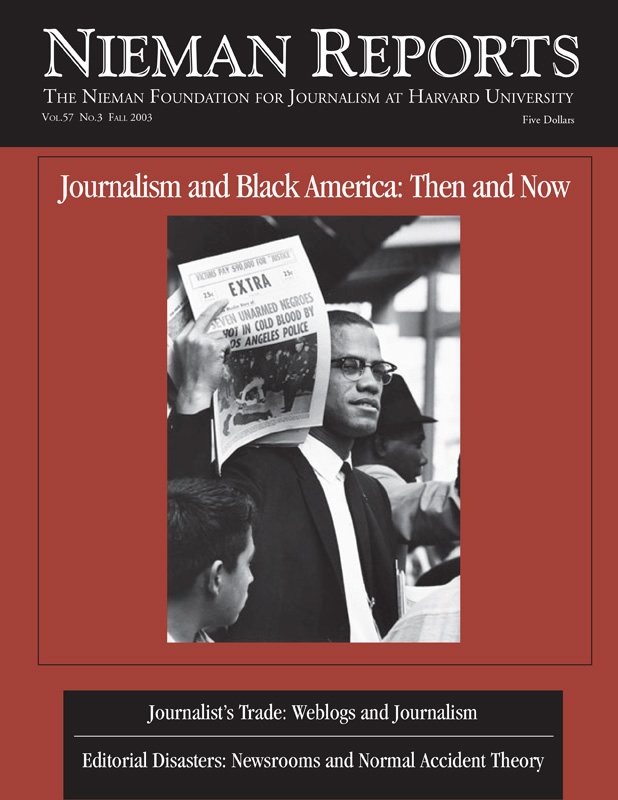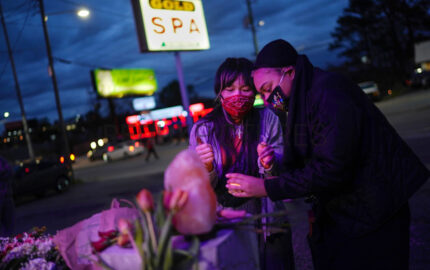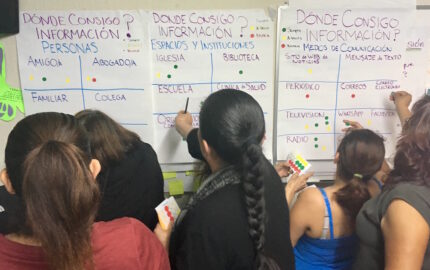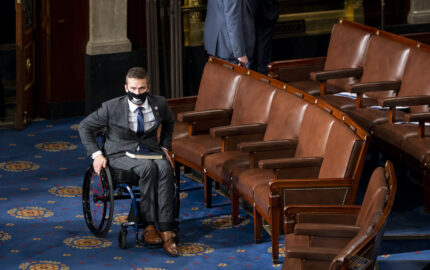Journalists are pretty good at covering issues in black and white. They quickly anoint the victims and the perpetrators, grade schools as soon as test scores are tallied, and paint Enron or WorldCom in Darth Vader hues. But when it comes to covering issues related to race relations, it’s less about covering the black and white and a lot more about exploring the gray.
Covering race is seldom about reporting the noise, except when overt hate crimes or police misconduct motivate news coverage. More often, stories about race emanate from reporting on uncomfortable silences that exist in every community—the ones that make people squirm. Chronicling race relations in the 21st century is less about covering external conflict, a common and easy definition of “news,” and more about capturing the internal tensions—a trickier challenge for journalists.
Because internal racial tensions are less noticeable, covering them requires journalists to abandon some knee-jerk habits and reach for a different set of skills. They need to engage in deep listening by:
Consider how deeper listening helped Mike Knepler at The Virginian-Pilot understand the role race was playing in the debate about a 1995 light-rail referendum. Hearing opponents talk about “bag ladies” and warn that riders are “going to meet a lot of people they didn’t meet before,” he heard a subtext that sounded almost like a coded appeal to those who fear blacks. Following these clues, he did more careful reporting. And in his stories, he established that light-rail opponents were exploiting a fear of ferrying black Norfolk residents down to Virginia Beach resorts.
Covering race relations in the new millennium is much different than covering it during the civil rights decade of the 1960’s. Then, journalists who were on the civil rights beat were seen as reporting to rectify wrongs and ensure equality. Right and wrong seemed pretty clear cut. Today, the terrain feels much softer, more confusing. “Solutions” that Baby Boomers might have embraced personally during the 1960’s are now cast aside as failing to remedy problems and even creating new ones. Busing to foster integrated schools? “No thanks,” many communities say, “Give us back our neighborhood schools.” Performance-based school accountability? Give us charter schools with some different markers for a “good education,” others insist. Higher education quotas to open up access? Justified, say some; illegal, counter others.
Difficulties in Reporting on Race
During the past decade, it’s become increasingly clear to us at the Pew Center that there are two overarching storylines or master narratives—failing schools and race relations—that ripple through nearly every community in different ways. These storylines frequently emerged in many proposals we received for funding of civic journalism projects in award entries and in independent initiatives.
Usually the failing schools story is also a race relations story because theRELATED ARTICLE
Reporting on the Minority Education Beat
- Tim Simmonsschools that are performing the worst have large minority student populations. Or these schools have high minority dropout rates. Or they receive fewer resources and have less skilled faculty than schools in more affluent neighborhoods. Moreover, reporters see year after year the patterns of performance gaps in the test scores of black and white students and struggle to write stories that address the problem rather than affix the blame.
Yet racial tensions in the community or racial issues in schools often don’t become news stories until some visible, noisy conflict emerges. Perhaps the governor slashes funding for elementary and secondary public schools and community protests surface. Or a political candidate lambastes poor test scores and finger-pointing ensues. Or the police unfairly target minority motorists.
Readers, listeners and viewers, however, don’t usually experience race as conflict. For them, race plays itself out as a shifting array of epiphanies and observations, difficult encounters, and tough choices. The pattern of these experiences over time rather than a particular incident that happened recently often provides the narrative thread for people’s conversations and stories about race relations. So, when journalists report about race through a lens of intense conflict, the stories don’t resonate with people’s experiences.
From a journalist’s perspective, however, eliciting and portraying such long-term patterns are tough. Often news organizations don’t have the appetite or patience for stories that can be filled with ambivalence and be kind of messy to write or tell. White journalists, not surprisingly, risk framing the stories they report through a white lens, while minority journalists often struggle to pitch ideas arising out of their experiences and perspective to less-than-eager editors. Good sourcing can also be an ongoing problem, especially when language issues become part of the equation. Sometimes reporters work from Rolodexes that are packed with “quote commandos”—people whom reporters elevate to community spokespersons even when they aren’t particularly validated or even respected within their own community.
Reporters’ Tools for Covering Race
In the more than 800 civic journalism efforts the Pew Center has collected since 1993, we began to detect some new patterns in the coverage of racial tensions. Having identified them, we reported further and assembled what we learned in a 108-page booklet called “Delving into the Divide: A Study of Race Reporting in Forty-Five U.S. Newsrooms.” Part how-to and part case study, the booklet serves as a road map for news organizations that are trying to find ways to report on issues involving race, such as increased immigration to or diversity within their communities.
The initiatives we cited employed a lot of classic civic journalism tools. They created venues for interactions that became listening posts for reporters. These helped journalists to identify leaders and understand the language people used to talk about their experiences. Of course, we also see in these efforts widespread use of “civic mapping,” one of civic journalism’s contributions to race relations reporting.
Civic mapping gives journalists a structure for going out in the community and finding new kinds of sources, so-called “catalysts” and “connectors.” The catalysts are the “go-to” people who attend to neighborhood business; local people tend to know who they are. Connectors are the civic bumblebees who pollinate a lot of community groups, from sports to scouts. Both are in short supply in journalists’ Rolodexes. Civic mapping also helps reporters identify “third places.” These are the spots where people informally gather and trade information. Most politicians know where third places are; fewer journalists do.
“Delving into the Divide” spotlights, too, many conventional tools for reporting on race, while featuring some that are unconventional. What follows are some that have been well replicated:
The goal in reporting about race relations is to bring a long-term perspective and a broad, encompassing approach to reporting these stories. I like to say that it’s the 5,000-foot view, not the 50-foot one, which results in the best news coverage. To strive to inform people not only about what happened yesterday but, more importantly, about how things are progressing over time, seems an approach that every journalist could benefit by pursuing.
Jan Schaffer is executive director of the Pew Center for Civic Journalism and director of its spin-off project, J-Lab: The Institute for Interactive Journalism at the University of Maryland. She was a reporter and editor for 25 years at The Philadelphia Inquirer, where she was a key part of the team of reporters that won the 1978 Pulitzer Prize for Public Service. “Delving into the Divide” can be ordered at www.pewcenter.org/doingcj/pubs/index.html.
Covering race is seldom about reporting the noise, except when overt hate crimes or police misconduct motivate news coverage. More often, stories about race emanate from reporting on uncomfortable silences that exist in every community—the ones that make people squirm. Chronicling race relations in the 21st century is less about covering external conflict, a common and easy definition of “news,” and more about capturing the internal tensions—a trickier challenge for journalists.
Because internal racial tensions are less noticeable, covering them requires journalists to abandon some knee-jerk habits and reach for a different set of skills. They need to engage in deep listening by:
- Asking more open-ended questions.
- Listening for patterns, not anecdotes.
- Seeking out new voices.
- Framing the story after, not before, doing the interviews.
- Burrowing deeper on code or buzz words to unpack what people really mean when they use them.
Consider how deeper listening helped Mike Knepler at The Virginian-Pilot understand the role race was playing in the debate about a 1995 light-rail referendum. Hearing opponents talk about “bag ladies” and warn that riders are “going to meet a lot of people they didn’t meet before,” he heard a subtext that sounded almost like a coded appeal to those who fear blacks. Following these clues, he did more careful reporting. And in his stories, he established that light-rail opponents were exploiting a fear of ferrying black Norfolk residents down to Virginia Beach resorts.
Covering race relations in the new millennium is much different than covering it during the civil rights decade of the 1960’s. Then, journalists who were on the civil rights beat were seen as reporting to rectify wrongs and ensure equality. Right and wrong seemed pretty clear cut. Today, the terrain feels much softer, more confusing. “Solutions” that Baby Boomers might have embraced personally during the 1960’s are now cast aside as failing to remedy problems and even creating new ones. Busing to foster integrated schools? “No thanks,” many communities say, “Give us back our neighborhood schools.” Performance-based school accountability? Give us charter schools with some different markers for a “good education,” others insist. Higher education quotas to open up access? Justified, say some; illegal, counter others.
Difficulties in Reporting on Race
During the past decade, it’s become increasingly clear to us at the Pew Center that there are two overarching storylines or master narratives—failing schools and race relations—that ripple through nearly every community in different ways. These storylines frequently emerged in many proposals we received for funding of civic journalism projects in award entries and in independent initiatives.
Usually the failing schools story is also a race relations story because theRELATED ARTICLE
Reporting on the Minority Education Beat
- Tim Simmonsschools that are performing the worst have large minority student populations. Or these schools have high minority dropout rates. Or they receive fewer resources and have less skilled faculty than schools in more affluent neighborhoods. Moreover, reporters see year after year the patterns of performance gaps in the test scores of black and white students and struggle to write stories that address the problem rather than affix the blame.
Yet racial tensions in the community or racial issues in schools often don’t become news stories until some visible, noisy conflict emerges. Perhaps the governor slashes funding for elementary and secondary public schools and community protests surface. Or a political candidate lambastes poor test scores and finger-pointing ensues. Or the police unfairly target minority motorists.
Readers, listeners and viewers, however, don’t usually experience race as conflict. For them, race plays itself out as a shifting array of epiphanies and observations, difficult encounters, and tough choices. The pattern of these experiences over time rather than a particular incident that happened recently often provides the narrative thread for people’s conversations and stories about race relations. So, when journalists report about race through a lens of intense conflict, the stories don’t resonate with people’s experiences.
From a journalist’s perspective, however, eliciting and portraying such long-term patterns are tough. Often news organizations don’t have the appetite or patience for stories that can be filled with ambivalence and be kind of messy to write or tell. White journalists, not surprisingly, risk framing the stories they report through a white lens, while minority journalists often struggle to pitch ideas arising out of their experiences and perspective to less-than-eager editors. Good sourcing can also be an ongoing problem, especially when language issues become part of the equation. Sometimes reporters work from Rolodexes that are packed with “quote commandos”—people whom reporters elevate to community spokespersons even when they aren’t particularly validated or even respected within their own community.
Reporters’ Tools for Covering Race
In the more than 800 civic journalism efforts the Pew Center has collected since 1993, we began to detect some new patterns in the coverage of racial tensions. Having identified them, we reported further and assembled what we learned in a 108-page booklet called “Delving into the Divide: A Study of Race Reporting in Forty-Five U.S. Newsrooms.” Part how-to and part case study, the booklet serves as a road map for news organizations that are trying to find ways to report on issues involving race, such as increased immigration to or diversity within their communities.
The initiatives we cited employed a lot of classic civic journalism tools. They created venues for interactions that became listening posts for reporters. These helped journalists to identify leaders and understand the language people used to talk about their experiences. Of course, we also see in these efforts widespread use of “civic mapping,” one of civic journalism’s contributions to race relations reporting.
Civic mapping gives journalists a structure for going out in the community and finding new kinds of sources, so-called “catalysts” and “connectors.” The catalysts are the “go-to” people who attend to neighborhood business; local people tend to know who they are. Connectors are the civic bumblebees who pollinate a lot of community groups, from sports to scouts. Both are in short supply in journalists’ Rolodexes. Civic mapping also helps reporters identify “third places.” These are the spots where people informally gather and trade information. Most politicians know where third places are; fewer journalists do.
“Delving into the Divide” spotlights, too, many conventional tools for reporting on race, while featuring some that are unconventional. What follows are some that have been well replicated:
- Giving news space to different perceptions. Journalists tend to want to validate a right or wrong. But truth is in the eyes of the beholder. Those journalists who report “truth” as a plural word, not a singular word, tend to hear more from community members, who feel they have some access.
- Polling, but only if it is done right. Respondents in race polls tend to give politically correct answers. Drafting the questions is the most important step in good polling. Perceptions always differ, even when aspirations are the same. Questions should be able to probe for both.
- Walking the streets and talking to people—before a story is framed. This works well because people open up if they think you don’t have a predetermined point of view.
- Creating venues for people to talk. These venues include focus groups, task forces, and video-conferencing. By doing this, reporters have heard poignant stories and built bridges to new sources.
- Debunking myths and addressing them straight on. This approach has produced its share of “aha” moments for reporters and readers.
- Fessing up. Some news organizations, such as The Jackson (Tenn.) Sun, have published a mea culpa, acknowledging that their past coverage was either biased or excluded big pieces of history.
- Inviting action. Letting people get involved and take ownership of the problem pays big dividends.
The goal in reporting about race relations is to bring a long-term perspective and a broad, encompassing approach to reporting these stories. I like to say that it’s the 5,000-foot view, not the 50-foot one, which results in the best news coverage. To strive to inform people not only about what happened yesterday but, more importantly, about how things are progressing over time, seems an approach that every journalist could benefit by pursuing.
Jan Schaffer is executive director of the Pew Center for Civic Journalism and director of its spin-off project, J-Lab: The Institute for Interactive Journalism at the University of Maryland. She was a reporter and editor for 25 years at The Philadelphia Inquirer, where she was a key part of the team of reporters that won the 1978 Pulitzer Prize for Public Service. “Delving into the Divide” can be ordered at www.pewcenter.org/doingcj/pubs/index.html.




